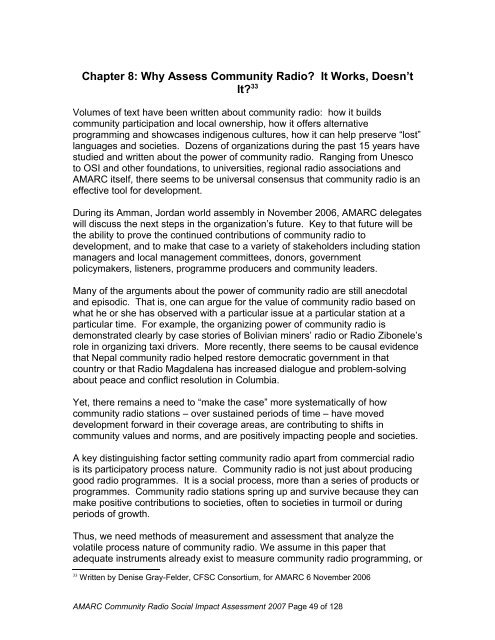Removing Barriers, Increasing Effectiveness - amarc
Removing Barriers, Increasing Effectiveness - amarc
Removing Barriers, Increasing Effectiveness - amarc
You also want an ePaper? Increase the reach of your titles
YUMPU automatically turns print PDFs into web optimized ePapers that Google loves.
Chapter 8: Why Assess Community Radio? It Works, Doesn’tIt? 33Volumes of text have been written about community radio: how it buildscommunity participation and local ownership, how it offers alternativeprogramming and showcases indigenous cultures, how it can help preserve “lost”languages and societies. Dozens of organizations during the past 15 years havestudied and written about the power of community radio. Ranging from Unescoto OSI and other foundations, to universities, regional radio associations andAMARC itself, there seems to be universal consensus that community radio is aneffective tool for development.During its Amman, Jordan world assembly in November 2006, AMARC delegateswill discuss the next steps in the organization’s future. Key to that future will bethe ability to prove the continued contributions of community radio todevelopment, and to make that case to a variety of stakeholders including stationmanagers and local management committees, donors, governmentpolicymakers, listeners, programme producers and community leaders.Many of the arguments about the power of community radio are still anecdotaland episodic. That is, one can argue for the value of community radio based onwhat he or she has observed with a particular issue at a particular station at aparticular time. For example, the organizing power of community radio isdemonstrated clearly by case stories of Bolivian miners’ radio or Radio Zibonele’srole in organizing taxi drivers. More recently, there seems to be causal evidencethat Nepal community radio helped restore democratic government in thatcountry or that Radio Magdalena has increased dialogue and problem-solvingabout peace and conflict resolution in Columbia.Yet, there remains a need to “make the case” more systematically of howcommunity radio stations – over sustained periods of time – have moveddevelopment forward in their coverage areas, are contributing to shifts incommunity values and norms, and are positively impacting people and societies.A key distinguishing factor setting community radio apart from commercial radiois its participatory process nature. Community radio is not just about producinggood radio programmes. It is a social process, more than a series of products orprogrammes. Community radio stations spring up and survive because they canmake positive contributions to societies, often to societies in turmoil or duringperiods of growth.Thus, we need methods of measurement and assessment that analyze thevolatile process nature of community radio. We assume in this paper thatadequate instruments already exist to measure community radio programming, or33Written by Denise Gray-Felder, CFSC Consortium, for AMARC 6 November 2006AMARC Community Radio Social Impact Assessment 2007 Page 49 of 128
















